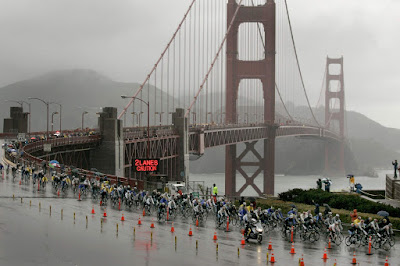
photo from Santa Rosa Press Democrat
Tour of California 2009 Stage 2 Race Highlights
source
Tour of California cyclists pedal through pain
By Ann Killion
source
Mercury News Columnist
Posted: 02/16/2009 09:55:18 PM PST
For more than four hours, Cam Evans suffered. Through buckets of rain. Through blasting headwinds. Through chunks of hail. Through temperatures dropping below 40 degrees.
"He looks miserable," I said from my shotgun seat in the Ouch team car, which was at the front of the race providing support to Evans during Stage 2 of the Tour of California.
"He is," Jeff Corbett, the team's assistant director, assured me.
Professional cycling is a sport of misery, every day, every race. The champions power through their pain for a few hours in exchange for glory.
But these first few days of the Tour of California have been a particular exercise in suffering, with horrendous conditions. Even Monday morning's trip across the Golden Gate Bridge was wet and nasty, and the thick cloud cover obscured all the spectacular views the organizers were banking on.
The conditions have been bad enough for Lance Armstrong to Twitter on Monday night that the Tour of California should be moved to late April, when weather conditions would be better. Armstrong had another eventful ride Monday, when he went down in a crash with a photography motorcycle. Word in the press room later was that the cameraman was one of Armstrong's own people, hired to do a documentary.
"This sport can certainly be dangerous," Armstrong said.
From my up-close, at times terrifying, vantage point in the Ouch car, the sport looked dangerous and wretchedly uncomfortable.
For five hours Corbett and mechanic Jordan Schware tracked their riders through the rain and wind. Evans, a 25-year-old cyclist from Vancouver, British Columbia, jumped into the breakaway early with nine others, including Watsonville's Ben Jacques-Maynes, on the Great Highway in San Francisco.
Ouch's leader, Floyd Landis, competing in his first race after serving a two-year suspension for a positive doping test, was tucked safely back in the peloton, the main group of riders. There Rock Racing, which was the leading team coming into Monday, controlled the pace.
Evans and the others stayed a few minutes ahead of the peloton during the entire, miserable morning: over Devil's Slide, through Half Moon Bay, over the Tunitas Creek climb, back down to the coast. Corbett tried to keep Evans fed and hydrated. He took in his soaking jacket for a climb and made sure it was back on the cyclist for the freezing descent. He kept encouraging him.
And then on the climb up Bonny Doon Road, the whole race blew apart.
"Here it goes, Cam," Corbett said into his radio. "Game on."
But the breakaway group started to crumble. The riders started to drop. And, like a man possessed, two-time defending champion Levi Leipheimer stormed up the mountain and swallowed them up, one by one.
"On the last climb, he was untouchable," said Armstrong, who knows something about breaking away. "Levi clearly showed he's the best rider in the race today."
Leipheimer, with eventual stage winner Tom Peterson on his wheel, sped down into Santa Cruz to reclaim the yellow jersey as the overall leader.
"That was a bit of a rough one," Evans said later, still shaking from the cold. "I don't know if I can pinpoint one part that was worse than the rest."
But when Leipheimer passed him, Evans didn't blink. He started suffering for someone else.
"At that point in the race I wasn't going to win the stage," he said. "So I shifted my focus into working for Floyd."
Landis was in the next group that included Armstrong and a host of other top riders who flew up the mountain behind Leipheimer. Evans tried to hang on to help Landis but couldn't. Landis was dropped from the chase group and was soon riding alone over the climb.
Hundreds of people lined the route — cycling fans are second only to riders in their love of misery. There were fans in gorilla suits, banana outfits, the obligatory devil, some holding signs for Jacques-Maynes and, of course, hundreds waiting for Armstrong.
For that subset of the public, the ones who will stand in a hailstorm to see a cyclist fly by at 40 mph, all seems forgiven with Landis — the only rider ever to be stripped of the Tour de France title. Landis is easily recognizable, with his jutting chin and wispy, red goatee, and he caused a loud cheer in his wake. He was showered with love and encouragement.
"I couldn't believe the number of people," Landis said through a team spokesman. "To get that kind of response is more than inspiring."
Who knows what motivates them all — a 25-year-old Canadian, a 37-year-old multimillionaire legend, a 33-year-old fallen hero. Why do they withstand hail and rain and burning legs? Why sign on for day after day of misery.
Fame? Victory? Wealth? Redemption? Each had his own reason and, on Monday, several damp, miserable hours to ponder it.
--- end ---
Drug Cases in Cycling, Baseball Intersect in Tour of California
By Mason Levinson
source
Feb. 17 (Bloomberg) -- Lance Armstrong and Floyd Landis, each staging career comebacks following Tour de France victories beset by doping controversies, were among the pack that crossed over the Golden Gate Bridge yesterday.
Competing in the nine-day Tour of California, the U.S.’s biggest cycling race, the span crossing into San Francisco put the sport in familiar territory. This is the city at the center of baseball All-Star Barry Bonds’s steroid case. It seems cycling can’t escape drugs, even when the shadow of performance enhancers comes from another sport.
“It feels good to actually have people finally realize that there is a doping culture out there in all sports,” said Bobby Julich, a U.S. cyclist who retired last year without ever being tied to a drug scandal. “Although we’ve taken it on the chin and guys continue to test positive, we were the first sport to really take action and not hide these positive results, even if they were from the most popular, highest-paid guys.”
The Tour de France, cycling’s marquee race, has been plagued by doping cases in each of the last three years. Landis is racing this week for the first time since he tested positive for synthetic testosterone during the 2006 edition and was stripped of the title after appeals and his steadfast denials. Armstrong never tested positive while winning a record seven Tour de France titles from 1999-2005, though doping allegations have followed his career. Tyler Hamilton, a 2004 U.S. Olympic cycling champion, was banned for two years in 2005 for blood doping.
Off Radar
“I don’t think cycling is really high on the American radar scope,” Richard Pound, a former president of the World Anti-Doping Agency, said in a telephone interview from Montreal. “The only reason it comes up are because of the well-publicized cases of Lance, Floyd, and I suppose Tyler Hamilton.”
Baseball’s drug cases have focused on the sport’s most famous players, though none has been suspended.
On March 2, Bonds, the sport’s all-time home-run leader, will go on trial in San Francisco on charges of lying to a federal grand jury about steroid use. That investigation also led to a six-month jail sentence for former track champion Marion Jones, who admitted she lied about steroid use and was stripped of the record five medals she won at the 2000 Olympics in Sydney.
Alex Rodriguez, the New York Yankees’ third baseman and a three-time Most Valuable Player, last week admitted to past steroid use. Roger Clemens’s 2008 testimony to Congress that he never used performance-enhancing drugs has led to a grand jury investigation of possible perjury in Washington. Clemens has won seven Cy Young Awards as his league’s best pitcher.
Baseball’s Image
“I would say that baseball has a much larger image problem, because it’s the nation’s pastime and steeped in so much tradition in this country,” says Kent Jarrell, a crisis- management expert with the Washington public relations firm Apco Worldwide Inc. “Cycling is still trying to get a foothold. In effect, they don’t have as much to lose because people don’t have an opinion of them.”
The Tour of California, a 750-mile (1,207-kilomter) race that started in Sacramento on Feb. 14 and ends in San Diego County, could help introduce cycling to Americans for reasons other than drug violations.
“It’s become one of the top five races in the world,” said Phil Liggett, who is calling the tour as the Versus network airs live coverage each day for the first time. “That’s justified by the quality of the field. It’s been great for California, and as far as cycling goes, it’s one to ride now.”
Big Crowds
The race’s organizer, AEG Sports, said the Tour of California drew 1.6 million spectators in 2008 as Levi Leipheimer, Armstrong’s Astana teammate, won for the second straight year following Landis’s victory in the debut edition.
Leipheimer will be wearing the yellow jersey as the race leader during today’s third stage, from San Jose to Modesto. Yesterday, he finished just behind stage winner Thomas Peterson to grab the overall race lead, while Australia’s Michael Rogers is in second place, 24 seconds back. American David Zabriskie is third (28 seconds behind), followed by Armstrong (30 seconds behind) in fourth. Landis is currently in 29th position, while Hamilton is 105th.
If the crowds that watched Armstrong’s 29th-place finish at Australia’s Tour Down Under in January are an indication, attendance in California will grow substantially this year.
“It was absolutely incredible the reception he received in Australia,” Liggett said in a telephone interview. “I don’t think I’ve ever seen a comeback by a sportsman quite like it.”
Armstrong’s return hasn’t been free of doping issues. Last week he scrapped his plan to participate in a strict, publicly posted drug-testing program run by anti-doping scientist Don Catlin. The private program, which Armstrong touted during his comeback announcement in September, proved too costly and difficult to administer, both parties agreed. Armstrong is still tested by the numerous bodies that govern cycling and doping, as well as his own racing team.
However the race unfolds, its winner and most popular figures know that they’ll be quickly punished if they don’t ride clean, Julich said in a telephone interview.
“In that sense, we’ve already crossed the Golden Gate Bridge and we’re coming to the other side, where hopefully we’ll be able to weed out doping entirely,” he said.
To contact the reporter on this story: Mason Levinson in New York at mlevinson@bloomberg.net.


No comments:
Post a Comment